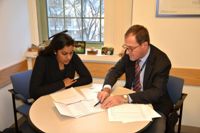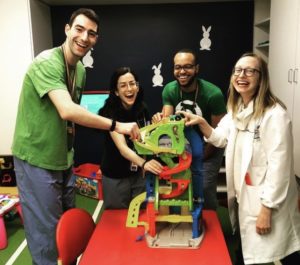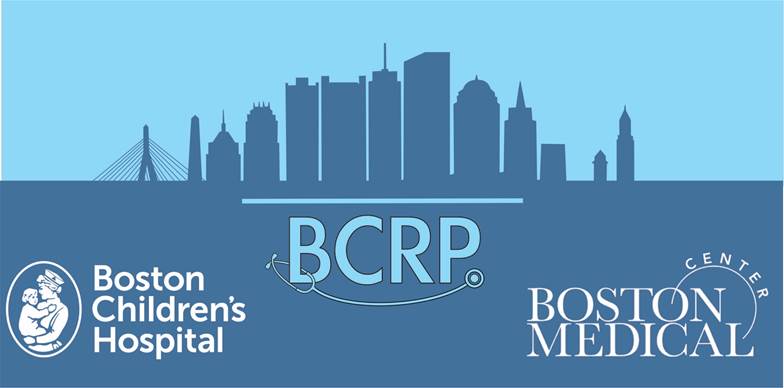Tracks
The Boston Combined Residency Program in Pediatrics at Boston Children’s Hospital and Boston Medical Center emphasizes training in general pediatrics for all residents, regardless of their ultimate career plans. The program offers two tracks:
- Categorical Track — emphasizing training in academic medicine and pediatric subspecialties. This track includes the combined residencies that are based at Boston Children’s Hospital
- Leadership in Equity and Advocacy Track — emphasizing training in health equity, public policy and advocacy
Categorical Track

The Categorical Track (NRMP #1259320C0) is designed for applicants who wish to focus on academic general or specialty pediatrics. Besides the strong educational base in general and subspecialty pediatrics, principles of academic leadership are actively taught throughout the three-year training program. About 85% of the Categorical track graduates enter subspecialty fellowships or academic general pediatrics fellowships, but some pursue pediatric practice, hospitalist positions, global health and health policy experiences, and health services research training programs.
Categorical track residents have opportunities for research funding, exposure to academic meetings and active mentoring by subspecialty faculty. Most residents participate in the standard three year curriculum; however, the two research tracks of the American Board of Pediatrics — the Integrated Research Pathway and the Accelerated Research Pathway — are available to housestaff pursuing academic research careers. In fact, the BCRP has had the most residents participate in these so-called “fast-tracking” pathways of any pediatric program in the country. An article from the Journal of Pediatrics describing these pathways can be found here.
Categorical residents do approximately 80 percent of their training at Children’s Hospital Boston and 20 percent of their training at Boston Medical Center.
Leadership in Equity and Advocacy Track

The Leadership in Equity and Advocacy (LEAD) (NRMP #1259320C1) is distinguished by a mission to develop leaders in pediatrics who will dedicate their careers to health equity and advocacy. This encompasses a focus on understanding and addressing the ways sociodemographic and physical environment features affect health, with a specific lens on how those have been shaped by structural racism, environmental injustice, and other forms of oppression that drive health inequities. This also includes a focus on understanding our local resource infrastructure and the inequities that exist within our systems, such as housing and education, and developing the tools as pediatric leaders to address these gaps.
Residents in LEAD are exposed to the domains of public health, policy, legislative and media advocacy, community-based research, health services research, quality improvement, and global health through structured curriculum and delve deeper into certain areas based on personal passions and interests. Beginning in the PL2 year, LEAD residents select an additional half-day experience to augment their training. Residents have the option of having protected time to pursue a project in an area of interest or spending time in a second continuity clinic. Projects are conducted with strong faculty mentorship and range from creating community health initiatives, to pursuing health services research, to designing medical education curricula on advocacy and health equity, and beyond. The LEAD curriculum is enhanced by monthly educational Research, Advocacy, and Policy (RAP) sessions led by PL3 residents, as well as by individual mentorship and career/project guidance through our portfolio advisor system.
LEAD residents engage in the LEAD curriculum while obtaining exceptional clinical training to prepare for a career in areas ranging from primary care to subspecialty pediatrics. They often pursue clinical fellowships, health services research fellowships, academic general pediatric fellowships, advocacy fellowships, and masters programs in public health or policy. Many LEAD graduates have careers as researchers in academic medicine, while others serve as advocates, community leaders, policymakers, and clinicians.
LEAD residents spend 35 percent of their time at Boston Medical Center and 65 percent at Children’s Hospital. Inpatient general pediatrics rotations are spent primarily at Boston Medical Center in the PL2 and PL3 years.
Common Aspects
Both tracks are geared towards training outstanding general pediatricians. Rotations in the two tracks are very similar and all residents work at both institutions, but the faculties at Children’s Hospital and Boston Medical Center have different interests and the two institutions have a different focus, which allows residents to focus upon their individual goals and take advantage of the diverse resources to explore and prepare for careers in virtually any aspect of pediatrics.
It is important to emphasize that residents in the two tracks are all part of the same program and function as one. They are totally integrated in all aspects of the program and, aside from the program leaders, few faculty or staff know which residents belong to which track.
As described in detail in the Application section, each track has a separate match number through the National Resident Matching Program (NRMP) and has a separate selection process. Applicants can apply to either one or both tracks. Because the tracks are quite similar and the program is highly unified, and because most applicant’s interests overlap the missions of each track to some degree, most applicants should apply to both tracks.
Combined Pediatrics – Anesthesiology
The BCRP was one of the first residency programs to offer combined training in Pediatrics and Anesthesiology (NRMP #1259726C0). Residents spend their first year in pediatrics residency. The following year is the first year of anesthesiology training, followed by three years of integrated residency training in both pediatrics and anesthesiology. Throughout the three years of integrated training, while residents are doing core training in Pediatrics or Anesthesiology, they attend conferences and participate in core clinical activities once a month in the other discipline to keep the combined program fully integrated.
Individuals ideally suited for this combined training will likely pursue careers at the interfaces between critical care, pediatrics, and anesthesiology. Examples of such careers include hospitalist medicine, pain and palliative care, out of operating room procedural and sedations services, and members of integrated subspecialty teams in pediatrics, critical care and anesthesiology.
The program is described in detail here.
Combined Pediatrics – Medical Genetics
The BCRP is one of the few residency programs in the country that offers combined training in Pediatrics and Medical Genetics (NRMP #7652444017). The program is four years and offers the opportunity to be board-certified in both fields. Residents spend their first year in pediatrics residency. During the following two years, residents alternate between rotations in clinical genetics and pediatrics every six months. The fourth year is spent completing clinical genetics training, as well as a genetic research project. During their training in genetics, residents continue to attend their pediatrics primary clinics and are encouraged to participate in other BCRP educational programs.
The combined pediatrics-medical genetics residency is best suited for individuals who have a clear interest in medical genetics at the time of application. These individuals may envision clinical careers in genetics and genomics, biochemical genetics, complex care, or careers in research, bioethics, or advocacy for individuals with genetic disorders.
The program is detailed here.
Combined Pediatrics – Child Neurology
The BCRP offers two different Pediatrics-Child Neurology programs: one a joint program between the Categorical Track and the Child Neurology program at Boston Children’s Hospital (NRMP #1259185C0), the other is between the Urban Health and Advocacy Track and the Child Neurology program at Boston Medical Center (NRMP #1257185C0). These two “Categorical” programs both begin with two years of general pediatrics in the appropriate track of the BCRP followed by three years of child neurology at either Boston Children’s Hospital or the Boston Medical Center. Both child neurology programs also offer separate “Advanced” positions that are not linked to the BCRP, where the matched residents first complete their two years of general pediatrics in some other program.
The child neurology programs at Boston Children’s Hospital are described in detail here.
The programs at Boston Medical Center are described here.
Triple Board Program
Boston Children’s Hospital and Tufts jointly host the longstanding Triple Board Program that existed at Tufts until the recent closure of the Tufts Pediatrics Residency Program. The Triple Board Program is a combination of residency programs in Pediatrics, Psychiatry and Child and Adolescent Psychiatry. Two residents per year will be selected via the Match. Graduates of this program will meet the growing workforce needs to serve patients with behavioral and mental health disorders. Boston Children’s Hospital, in partnership with Franciscan Children’s Hospital, is planning to establish a large inpatient psychiatric facility in Massachusetts for children and young adults who require inpatient services.
More information is available here.
Global Health Pathway
Three residents per year will be selected via a competitive application process for the Global Health Pathway of the BCRP. The goal of this pathway is to provide each resident with mentorship for global health careers, with dedicated individualized academic afternoons during retreats (replacing a BCRP Academy), to provide a community including dedicated faculty mentors, and to support the generation of additional resident-driven curricula, including journal clubs and networking events. Residents in this pathway would also work with their mentors to help plan 4 weeks of contiguous call-free elective time for global health electives/fieldwork in the junior year, and seniors will have 6 weeks of contiguous call-free time for global health fieldwork. Incoming interns in either the categorical or LEAD tracks will apply immediately after matching.
Harvard BWH/BCH Med-Peds Residency
The Harvard Associated Medicine & Pediatrics Programs were established in the late 1980s. The highly competitive program at the Brigham and Women’s Hospital and Children’s Hospital is fully integrated into each categorical residency. Med-Peds residents have the same supervision, responsibilities and opportunities as their medicine and pediatrics colleagues and are a vital part of the BCRP. More information about the Harvard BWH/BCH Med-Peds Program is available here.



